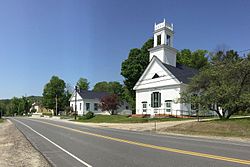Top Qs
Timeline
Chat
Perspective
Croydon, New Hampshire
Place in New Hampshire, United States From Wikipedia, the free encyclopedia
Remove ads
Croydon is a town in Sullivan County, New Hampshire, United States. The population was 801 at the 2020 census.[2]
Remove ads
Remove ads
History
Incorporated in 1763, the town takes its name from Croydon, a suburb of London, England.[3]
Croydon was home to Ruel Durkee, a powerful 19th century political boss in the state. The town of "Coniston" in the 1906 best-selling novel of the same name, by American author Winston Churchill, is based on Croydon, and Durkee was portrayed as "Jethro Bass". The local Coniston General Store is named after the novel,[4][5] as are YMCA Camp Coniston and Lake Coniston in the eastern part of the town.[6]
Remove ads
Geography
According to the United States Census Bureau, the town has a total area of 37.5 square miles (97.2 km2), of which 36.8 square miles (95.2 km2) are land and 0.77 square miles (2.0 km2) are water, comprising 2.07% of the town.[1] The highest point in town is Croydon Peak, at 2,760 feet (840 m) above sea level near the northwestern corner of the town. The North Branch Sugar River flows southward through the east-central part of the town. Croydon lies fully within the Connecticut River watershed.[7]
Croydon is home to Corbin Park, one of the largest private game reserves in New England. The 24,000-acre (9,700 ha) fenced-in expanse of woodlands and mountainous terrain features bison, European boar and elk and extends into neighboring towns.[8]
Adjacent municipalities
- Grantham (north)
- Springfield (northeast)
- Sunapee (east)
- Newport (south)
- Cornish (west)
- Plainfield (northwest)
Remove ads
Demographics
Summarize
Perspective
As of the census[10] of 2000, there were 661 people, 264 households, and 194 families living in the town. The population density was 17.8 inhabitants per square mile (6.9/km2). There were 354 housing units at an average density of 9.5 per square mile (3.7/km2). The racial makeup of the town was 97.43% White, 0.45% Native American, 0.15% Asian, 0.76% from other races, and 1.21% from two or more races. Hispanic or Latino of any race were 0.61% of the population.
There were 264 households, out of which 29.2% had children under the age of 18 living with them, 58.0% were married couples living together, 8.3% had a female householder with no husband present, and 26.5% were non-families. 19.3% of all households were made up of individuals, and 8.7% had someone living alone who was 65 years of age or older. The average household size was 2.50 and the average family size was 2.71.
In the town, the population was spread out, with 22.7% under the age of 18, 4.7% from 18 to 24, 30.4% from 25 to 44, 30.0% from 45 to 64, and 12.3% who were 65 years of age or older. The median age was 41 years. For every 100 females, there were 109.2 males. For every 100 females age 18 and over, there were 102.0 males.
The median income for a household in the town was $49,688, and the median income for a family was $50,556. Males had a median income of $31,992 versus $26,544 for females. The per capita income for the town was $21,403. About 2.5% of families and 4.9% of the population were below the poverty line, including 5.0% of those under age 18 and 9.7% of those age 65 or over.
Remove ads
Politics
Summarize
Perspective
In recent decades, Croydon has supported Republicans in presidential elections.
In 2022, Croydon made headlines after citizens organized an emergency town meeting against a school board amendment that had cut the public school budget by more than half. Repeal of the amendment passed by 377-2.[19] The story of the repeal was covered on This American Life on July 29, 2022.[20]
Remove ads
Notable people
- Augusta Cooper Bristol (1835–1910), poet, lecturer
- Jonas Cutting (1800–1876), Maine Supreme Judicial Court justice
- Wallace L. Dow (1844–1911), architect
- Whitman G. Ferrin (1818–1896), attorney and politician
- Samuel Read Hall (1795–1877), educator
- Gershom Powers (1789–1831), United States representative
- Baron Stow (1801–1869), Baptist minister
References
External links
Wikiwand - on
Seamless Wikipedia browsing. On steroids.
Remove ads


